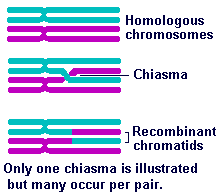
|
Student's Study Guide for Lesson Five
by Dr Jamie Love |

|
 and
and  licensed under a Creative Commons Attribution-ShareAlike 4.0 International License.
licensed under a Creative Commons Attribution-ShareAlike 4.0 International License.

|
Student's Study Guide for Lesson Five
by Dr Jamie Love |

|
The ___________ direction in which the tetrad breaks up (in meiosis I) leads to a wide variety of possible gametes.
That variety increases as the number of chromosomes _________.
1. An organism with only one homologous pair of chromosomes can
only produce ___ types of gametes -
one carrying the #1P and the other carrying the #1__.
2. An organism with two homologous pairs (of chromosomes) can produce four types of gametes. These would be
Each gamete must have ___ of each chromosome number.
3. You have 23 pairs of homologous chromosomes so you have a
haploid number of __ and a diploid number of __ because your n
= 23.
We could have had any combination as long as we ended up with
one chromosome from each homologous pair (one #1, ___ #2, one
#3, etc.) There are millions of possible ____________.
By the time chromosomes become visible in prophase I they are
already paired as ______ and tangled together, entwined in
a process called ________.
Synapsis is a highly specific and organized _________ of the homologous
chromosomes causing their genes (the specific DNA segments) to
____ __. Their DNA stands actually break and they swap bits of
DNA between ________. This exchange of genetic material is called
______ ______ and it produces new ____________ of genetic
material along both chromosomes. The chromatids involved in crossing
over will have the same ____ of genetic materials but the swapping
may have introduced some new types of genetic materials.
|
Crossing over is inferred from the patterns of crossed over ___________.
These regions are called _________ (meaning "cross" in Greek). Chiasma is the singular form. There are many chiasmata along the length of a pair and many crossing over events occur among all ____ chromatids in the pair of homologous chromosomes. Each chiasmata represents a ______ ___ event and causes recombination along those parts of the chromatids undergoing the exchange. |

|
(How would the location of different genes along the chromosome
affect the frequency of crossing over?)
[__________________________________________________________________________________________.]
(What's the difference between centromeres entering mitosis and
centromeres entering meiosis I?)
[____________________________________________________________________________________________.]
|
Chiasmata help to place the tetrad pairs along the _______ I plate.
When a pair of chromatids become tangled in chiasmata they effectively lock the two chromosomes (dyads) together into a _____. |

|
If something goes wrong in anaphase I or anaphase II of meiosis the resulting _______ might not have the correct number of chromosomes. One gamete may get 22 chromosomes and the other would get 24 chromosomes.
(What would be the result, chromosome count, of the fusion of
either of those "bad" gametes with a healthy gamete?)
[_________________________________________.]
When the number of chromosomes in a cell is "off" by
one or a few, we call that condition __________.
Down syndrome is also called "trisomy 21" because
people with Down syndrome have an extra copy of chromosome #__.
Sometimes a gamete has the correct number of chromosomes but one of them is damaged, perhaps missing a piece of genetic material. There are several human genetic diseases caused by "______ ___________" but fortunately they are rare. The chromosome is usually broken at some stage before meiosis and the damaged chromosome passes through meiosis as normal. Zygotes produced from such chromosomes are _________ in genetic materials and that usually causes some severe problems.
Chromosomes are arranged from the _______ (number one, or #1) to the smallest (number twenty-two, or #22, in the case of ______) - not counting the two ___ chromosomes.
|
The "short" portion is given the designation "_"
and the "long" portion is labeled "_". Special
staining procedures produce bands spread unevenly but ____________
along the length of each chromosome.
A ________ on a chromosome is called a locus. Genetic information is contained at each locus. Each set of chromosomes has one and only one #5p15 and we always refer to that as a single position (locus) even though there may be several copies or __________ of it. At a different locus in the set, say on a different chromosome (#4) or a different position (#5p13), there will be _________ genes. Two genes cannot share the same _____ (but __________ of the same gene can). Different genes reside at _________ loci (the plural of locus). |

|
Polyploidy is when the organism has extra ____ of chromosomes so its cells have 3n, or 4n, or 5n, etc. In polyploidy the chromosomes are increased in _____ units of "n".
You can sometimes "force" a hybrid plant through its sterility by adding __________. Colchicine disrupts nuclear division by inhibiting the formation of spindle fibers.
(How might this be used in a lab to help you see and count chromosomes?)
[_____________________________________________________________________________________
__________________________________________________.]
Many families of wild flowers are composed of species that consist of simple _____ of a basic number of chromosomes - the basic number being "n". Polyploidy is ______ among plants, ____ among animals and _____ for humans.
Broken and rearranged chromosomes can be involved in evolution.
Chimpanzees and gorillas have __ chromosomes because they have
two extra pairs of chromosomes (so they should have 2n = 50) but
they do not have human chromosome pair #2 (so they really have
2n = 48).
Human gametes have 23 chromosomes but chimp and gorilla gametes
have ___ chromosomes.
Careful analysis of the chromosomes shows that the human #2 was
actually produced by the ______ of the two sets of ape chromosomes!
These chromosomal rearrangements are markers of chromosome evolution
and they may also act as a reproductive _____ that made it impossible
for our ancestors to mate with the ancestors of chimps and gorillas.